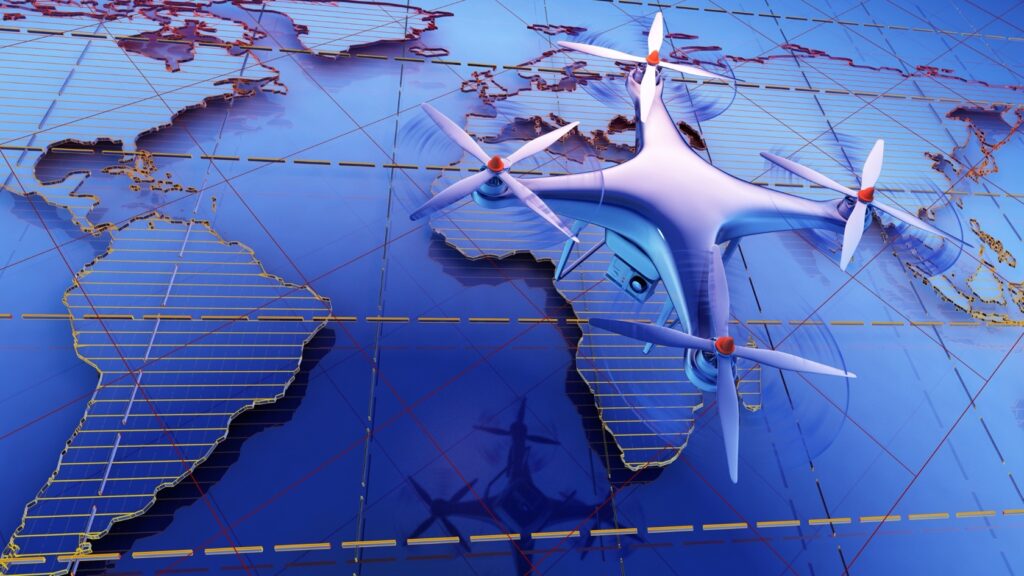Just like in the early years of commercial aviation, when aircraft became larger, faster, and more advanced, as with the launch of the first Boeing 747 in 1969 and its debut in 1970 with PAN AM, the first flight of the A300, or the iconic Concorde, today we are witnessing a new conquest of the skies: the drone.
This aircraft has burst onto the scene, quickly revolutionizing the aviation market in areas such as advertising, services, security, and entertainment. Beyond its practical uses, it has captured our imagination; every day we are amazed by its constant evolution and its steady path to becoming an essential piece of the global economy. Its presence is no longer just a hobby but a trend that is redefining our relationship with the sky and with technology.
Formally known as a Remotely Piloted Aircraft System (RPAS), today the drone is defined by the International Civil Aviation Organization (ICAO) as “an aircraft without a pilot on board, controlled remotely by an operator or through a pre-programmed system.” Simply put, it is an aircraft that does not need a pilot on board to fly, but is operated remotely or even fully autonomously, opening up endless possibilities that not so long ago seemed like science fiction.
From a historical perspective, the first prototypes of these aircraft appeared in the early 20th century, initially used for military purposes such as target practice and reconnaissance missions, thus avoiding risking human lives. Just a few years later, during World War II, rudimentary radio-controlled planes were already being tested, and by the Cold War, drones had consolidated as key tools for espionage and surveillance.
In a very short time, this technology made a spectacular leap: it went from being an exclusive military resource to becoming a revolutionary tool indispensable in agriculture, logistics, filmmaking, and public safety. Today, drones are already part of our daily lives and are ready to take the next big step: carrying passengers and opening a new chapter in aerial mobility.
In 2018, ICAO introduced Amendment 175 to Annex 1, marking the beginning of a new chapter: the first international standards for remote pilot licenses, scheduled to come into force in November 2022. This advance required States to create new technical professional profiles within the authorities and to establish clear requirements for training, licensing, and medical checks for those operating drones.
Due to this global shift, the United States became a pioneer by implementing regulation 14 CFR Part 107, establishing operator certification and general permits for commercial flights without the need for special authorizations. Today, U.S. regulations limit drones to altitudes below 400 feet (about 120 meters), require line-of-sight (VLOS) operations, and prohibit flying near airports without authorization. To simplify this, the U.S. developed and implemented the LAANC system and introduced measures like Remote ID, which requires real-time transmission of location and identification data, effectively working as a “digital license plate.” Europe, meanwhile, adopted similar regulations in 2020, requiring registration and notification of flights in sensitive areas. Integrating drones into shared airspace remains a huge challenge, but thanks to this model initially presented by the FAA, operators can be ensured to be prepared.
Rest assured, drones are no longer just flying cameras: in agriculture, they help monitor crops and optimize resources; in logistics, companies like Amazon Prime Air and Zipline are exploring rapid deliveries and medical shipments to remote areas; in emergencies, they enable search and rescue operations and wildfire monitoring; and in infrastructure, they inspect towers, bridges, and pipelines, reducing human risks. New applications that seem taken from a futuristic novel emerge every day — and the best part is that we’re only just beginning.
Sooner than you think, we may see drones transporting passengers from one point to another as flying taxis. This concept, known as eVTOL (electric Vertical Take-Off and Landing), involves electric aircraft capable of vertical take-off and landing, ideal for navigating congested cities. Currently, companies like Joby Aviation and Volocopter are already testing prototypes, moving closer to a future where the sky becomes a new urban highway. However, there are still major challenges ahead, such as gaining public trust.
It may sound like a science fiction story, but soon we will see these aircraft above our heads, opening a fascinating chapter that will forever transform mobility. Drones are marking a before and after in how we see the sky and its possibilities. From secret military machines, they have become indispensable allies for agriculture, logistics, and, soon, passenger transport.
As we move into this new era, it is impossible not to feel a hint of nostalgia for that classic aviation that made us dream of open wings, thunderous sounds, and humans at the controls. But time does not stand still, and neither do we. The future calls us to dream big and to fly beyond what we ever imagined.
In upcoming articles, we will explore in detail how drones are transforming fields, revolutionizing package delivery, and getting ready to carry us on board in a future that is already knocking at our door.

